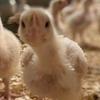Maintaining Poultry Welfare: Identifying Pain and Deciding about Treatment or Euthanasia



- Escape – animals may try to get away from or avoid a situation that might cause pain
- Guarding or favoring an injured body part, which may impact how the bird sits, stands or moves
- Vocalizing or being aggressive when someone tries to move or handle them
- Withdrawing from a stimulus, situation or person, or showing avoidance behavior
- Pecking or scratching the injured or painful body part
- Changing body posture; appearing restless and/or uncomfortable
- Behavioral changes such as hiding more than usual, being depressed, slow or sluggish, being motionless or having sleeplessness
- Having difficulty breathing or breathing more rapidly or slower than typical
- Having muscle spasms, tremors or tightness
- Learning about pain is important for animals to be able to avoid subsequent situations or things that might cause pain
- Pain helps animals heal and recover from injuries because animals will avoid using their injured limb or other body part
- Although pain is functional, pain reduces welfare and can reduce productivity
- When animals are experiencing pain for long periods of time (chronic pain) and cannot avoid further pain, then pain leads to suffering and decreases welfare even further
- Lameness
- Diseases and parasites (see PEC volumes15 and 17)
- Injuries
- Skeletal fractures (see PEC volume 12)
- Joint disorders such as arthritis and other leg issues (see PEC volume 11)
- Conditions causing inflammation (see PEC volume 18)
- Injurious pecking behavior (see PEC volume 7)
- Footpad dermatitis-see image to the right (and see PEC volume 9)


American Veterinary Medical Association. 2020. Guidelinesfor the Euthanasia of Animals: 2020 Edition. Available online: https://www.avma.org/sites/default/files/2020-01/2020-Euthanasia-Final-1-17-20.pdf
Boyal, R. S. , R. J.Buhr, C.Harris, L. Jacobs, and Dianna Bourassa. Poultry Euthanasia: Electrical Euthanasia Device. The Alabama Cooperative Extension System. September18, 2020
Boyal, R. S. , R. Jeff Buhr, CaitlinHarris, L. Jacobs, and Dianna Bourassa. Poultry Euthanasia: Koechner Euthanizing Device. The Alabama Cooperative Extension System. September18, 2020
Boyal, R. S. , R. Jeff Buhr, CaitlinHarris, L. Jacobs, and Dianna Bourassa. Poultry Euthanasia: Single Bird Carbon Dioxide System. The Alabama Cooperative Extension System. September18, 2020
Gregory,N. G. 2004. Pain. Chapter10 in Physiology and behaviour of animalsuffering. Gregory,N. G. (ed.). Blackwell Publishing, Ames, IA. Pp 94-100.
International Association for the Study of Pain. 2022. IASP Announces Revised Definition of Pain. Available online: https://www.iasp-pain.org/publications/iasp-news/iasp-announces-revised-definition-of-pain/
Jacobs, L., D. V. Bourassa, C. E.Harris, and R. J. Buhr. 2019. Euthanasia for Broiler Chickens: Manual and Mechanical Cervical Dislocation Methods, Virginia Cooperative Extension publication | Virginia Tech. APSC-161P
Linares, J. A., S. Dougherty, and S. Millman. 2018. Poultrywelfare assessment on the farm: focusing on the individual. Chapter 7 in Advancesin Poultry Welfare. Mench, J. A. (ed.). Woodhead Publishing, Cambridge, MA. Pp 131-146.





















